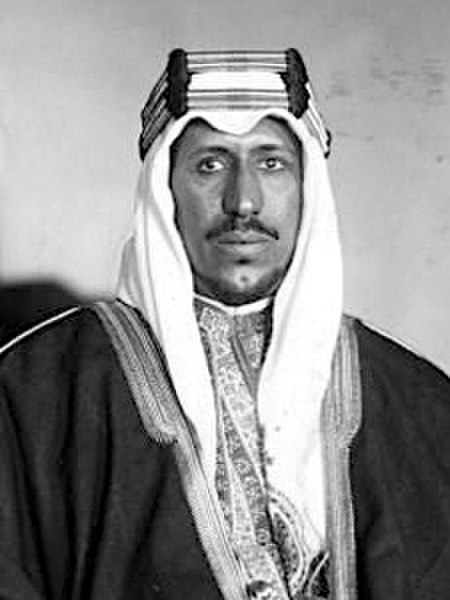Saud bin Abdulaziz Al Saud was King of Saudi Arabia from 9 November 1953 until his abdication on 2 November 1964. During his reign, he served as Prime Minister of Saudi Arabia from 1953 to 1954 and from 1960 to 1962. Prior to his accession, Saud was the country's crown prince from 11 May 1933 to 9 November 1953. He was the second son of King Abdulaziz, the founder of Saudi Arabia.
Official portrait, 1960
Crown Prince Saud being received by Snouck Hurgronje (right) at Leiden University, 1935
Crown Prince Saud, 1952
With his father King Abdulaziz (seated) and half-brother Prince Faisal (later king, left), early 1950s
The King of Saudi Arabia, officially the King of the Kingdom of Saudi Arabia, is the monarch and head of state/government of the Kingdom of Saudi Arabia who holds absolute power. He is the head of the Saudi Arabian royal family, the House of Saud. The king is the supreme commander-in-chief of the Royal Saudi Armed Forces and the head of the Saudi national honors system. The king is called the "Custodian of the Two Holy Mosques", a title that signifies Saudi Arabia's jurisdiction over the mosques of Masjid al-Haram in Mecca and Al-Masjid an-Nabawi in Medina. The title has been used many times through the history of Islam. The first Saudi king to use the title was Faisal; however, King Khalid did not use the title after him. In 1986, King Fahd replaced "His Majesty" with the title of Custodian of the Two Holy Mosques, and it has been since used by both King Abdullah and King Salman. The king has been named the most powerful and influential Muslim and Arab leader in the world according to the Muslim 500.

King of Saudi Arabia
Image: Official Portrait of King Abdulaziz
Image: Saud IV of Saudi Arabia portrait 2
Image: Faisal II of Saudi Arabia portrait








